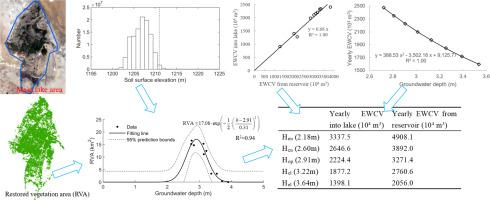Science of the Total Environment ( IF 8.2 ) Pub Date : 2021-05-15 , DOI: 10.1016/j.scitotenv.2021.147775 Shun Hu , Rui Ma , Ziyong Sun , Mengyan Ge , Linglin Zeng , Feng Huang , Jianwei Bu , Zheng Wang

|
Overexploitation of water resources has led to severe ecological degradation and even desertification in some arid inland river basins, northwestern China. To alleviate or restore the degraded vegetation ecosystem, ecological water conveyance (EWC) has become an important and effective measure. Scientific assessment of the impact of EWC on vegetation restoration and determination of the corresponding optimal EWC volume (EWCV) are important to formulate rational ecological water management. In this study, long time series normalized difference vegetation index (NDVI) was used to extract the restored vegetation area in Qingtu Lake area, a terminal lake in inland Shiyang River basin, northwestern China. The relationship between restored vegetation coverage and EWC was explored to determine the optimal EWCV. The restored vegetation area (RVA) increased dramatically in the first five years and became stable from 2016. The time lag of the response of RVA increase to EWC was about 2 years. A bell-shaped function between RVA and groundwater depth was obtained based on the results from Unmanned Aerial Vehicle (UAV) and micro terrain of the lake area. Based on the fitted function, five groundwater depth thresholds were obtained. The optimal groundwater depth in the hydrometric station was 2.91 ± 0.09 m for the maximal RVA (17.08 ± 3.25 km2). A polynomial function between the yearly EWCV and groundwater depth was developed and the EWCV thresholds corresponding to the groundwater depth thresholds were estimated. The optimal EWCV into Qingtu Lake was 2224.4 × 104 m3 for the maximal RVA. The correspondingly optimal EWCV from Hongyashan Reservoir was 3271.4 × 104 m3. The spatial distribution patterns of remotely sensed water surface and NDVI suggested that expanding the water-receiving area of conveyed water was useful to improve the vegetation growth. This study provides a reference for assessing the impact of EWC on vegetation restoration and determining the correspondingly optimal EWCV in arid inland river basins.











































 京公网安备 11010802027423号
京公网安备 11010802027423号